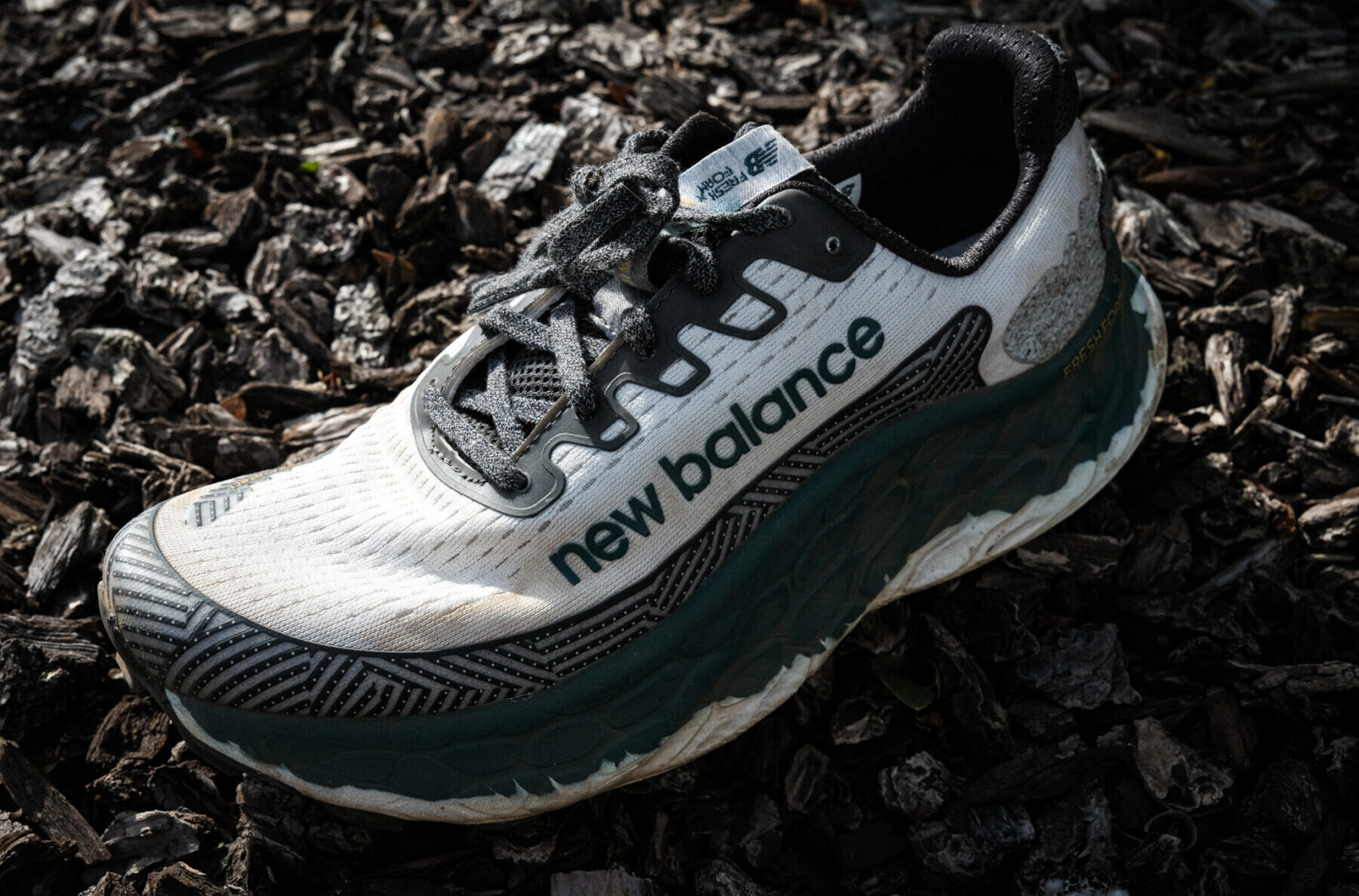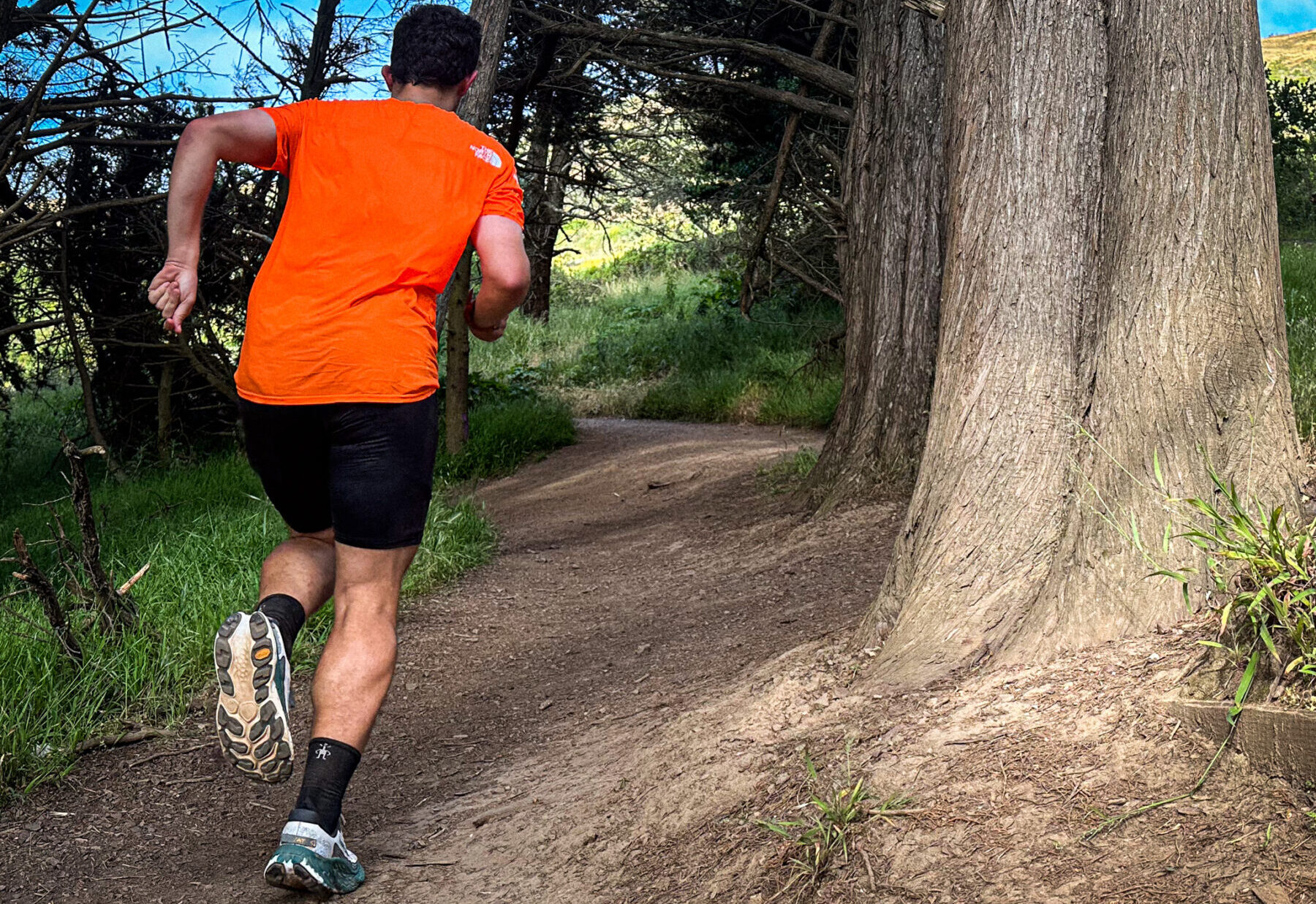New Balance Fresh Foam X More Trail v3
Test Location: Marin, CA
Test Duration: 75 miles (so far)
Stated Stack Height (Men’s): 30.5 mm (heel) / 25.9 mm (forefoot)
Stated Heel-to-Toe Drop: 4 mm
Stated Features:
- “Toe Protect” technology helps protect feet from rocks and roots
- “Vibram Eco-Step EVO” outsole
- Upper uses regrind textile waste
- Two-part ultra-soft “Fresh Foam X” midsole
- 5 mm lugs
Stated Weight per Shoe (US Men’s Size 9): 320 g / 11.3 oz
Blister Measured Weight per Shoe (US Men’s Size 8.5):
- Shoes + Laces: 280 g (left) & 278 g (right)
- Insoles: 16 g (left) & 16 g (right)
- Total: 296 g (left) & 294 g (right)
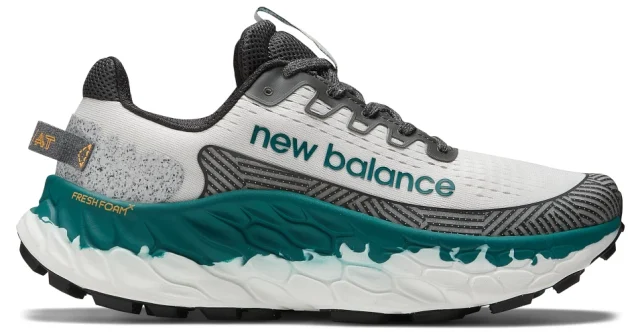
MSRP: $159.99
Size Tested: US Men’s 8.5 / EU 42
Reviewer: 5’9”, 150 lbs / 175 cm, 68 kg
Intro
The style of most of New Balance’s trail shoes have always gravitated toward the idiosyncratic. Many of their models don textured overlay, with swollen midsoles made from distorted shapes of foam. While perhaps slightly bizarre-looking, they’ve grown increasingly popular in recent years, likely a byproduct of New Balance’s premium technologies migrating over from their road line. Now, with the debut of the Fresh Foam X More Trail v3, perhaps the most cushioned trail shoe currently on the market, New Balance casts aside a “less is more” approach, quite literally. The third iteration of their maximal trail offering is no less than a hyper-cushioned, cartoonishly inflated, ultra-distance option that, aside from feeling quite comfortable after a few runs, has helped legitimize some of my claim to being 5’9”. In this prelude to a full review, I’ll break down the More Trail v3’s features and muse on some of my initial impressions.
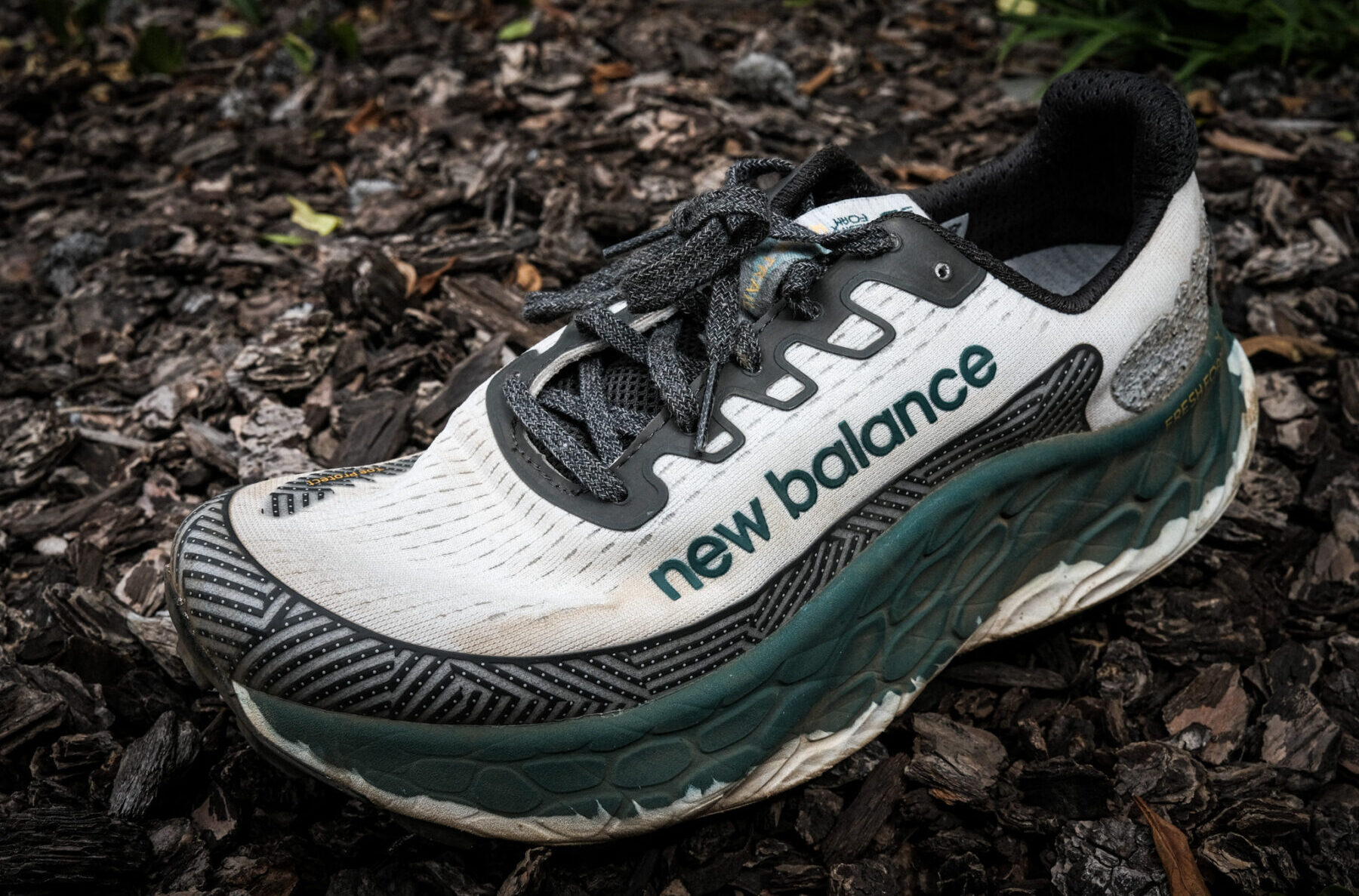
Fit & Features
New Balance’s stated stack height for the More Trail v3 is 30.5 mm / 25.9 mm. I’m not entirely sure where they are taking those numbers, to be frank. I’ve tested a bunch of maximal shoes within the past year, including Altra’s maximally stacked Olympus 5 (33 mm / 33 mm), and the More Trail v3 feels higher off the ground than even that. Accurately diagnosing stack height at home is near impossible, so what follows is at best just a guess, but I’d speculate that the shoe’s true measurements are probably something like 44 mm / 40 mm.
To help mitigate instability brought about by such a tall stack height, New Balance has made the More Trail v3’s platform appropriately wide. Its midsole extends a few millimeters out in each direction from the upper, creating a base that should reduce the shoe’s chances of capsizing. This also translates to a roomy, rounded toe box that allows for toe splay and supports foot swelling during longer efforts, and a forgiving fit through the midfoot that can be adjusted precisely because of the shoe’s lightweight, flexible upper. The fact that lock down hasn’t been hard to come by early on in testing bodes well for the More Trail v3’s future; since this model lacks a lot of ground feel, foot security and control become all the more important. I’d also note that, like with the New Balance Hierro v7 GTX that I’m also currently in the process of reviewing, the More Trail v3 runs true to my US Men’s size 8.5.
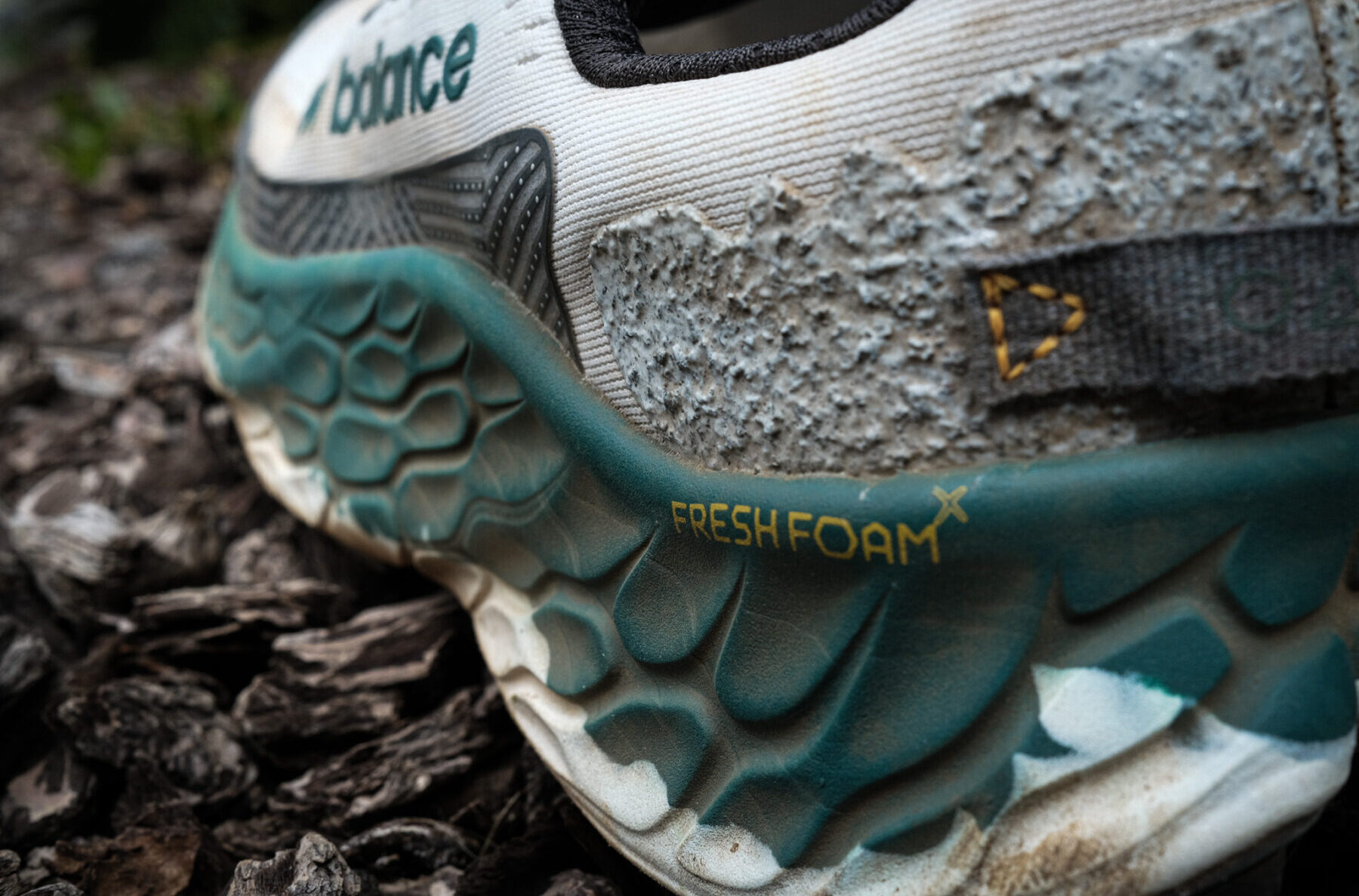
Being so elevated off the ground is an indirect form of protection. The More Trail v3 is designed to float over debris that could otherwise prove damaging to a model with a lower stack height. This advantage is reflected in the simplicity of its upper, which aside from a hard toe rand (New Balance’s “Toe Protect” technology), consists of a soft mesh construction that feels pretty conventional. The shoe’s gusseted tongue is extremely plush, wide enough to wrap the foot, and guard against potential lace-bite; its ankle collar is slight and minimally padded, much like its heel collar; and the heel counter is backed up by a semi-rigid plastic mold that seems to provide another anchor to secure the shoe’s fit. I am a little concerned that the More Trail v3’s relatively structureless upper could devolve into feeling baggy as I start to log more miles in the shoe, so that’ll be something I keep an eye on over the next couple of weeks.
Aesthetically, the More Trail v3 is pretty much all midsole. The shoe’s sidewalls rise up several millimeters above the footbed, creating an illusion that its stack height is even taller than it actually is. While I’m not the biggest fan of this look, I do think it makes sense from a design standpoint because doing so likely increases the shoe’s overall stability. New Balance has also elected to install a low heel-to-toe drop (4 mm) partnered with rockered sole geometry, a move typical of super maximalist shoes that, in theory, should help steadily transition the foot through its gait cycle. Hoka has relied on this setup for years, and based on their success, as well as my own experience, there’s little doubt that it works in a lot of contexts.
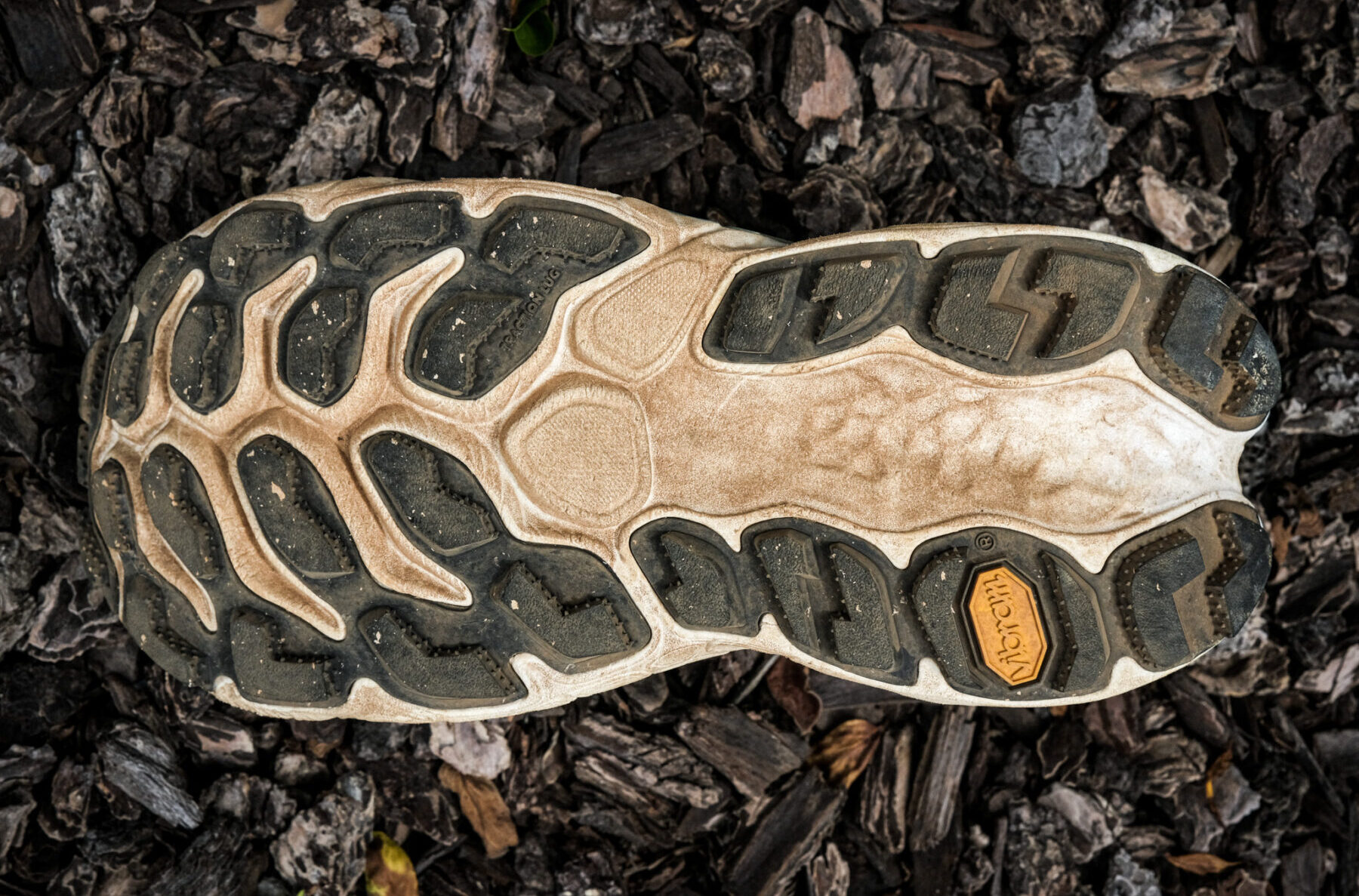
To draw another comparison between the More Trail v3 and Hoka, I can’t help but compare New Balance’s “Fresh Foam X” midsole material to the lightweight EVA Hoka uses in models like the Challenger 7, at least early on. Both foams are positioned for comfort first and foremost, meaning that they feel softer than popular performance composites like Nike “ZoomX.” If the way Hoka’s EVA ages is any indication, I’m a little worried that I’ll start to encounter the familiar “packing out” sensation in the More Trail v3 as I approach the 150-mile mark that seems to be where Hokas with a similar stack height begin to lose a ton of their energy return. However, out of the box the More Trail v3’s midsole is bouncy, forgiving, and deceptively airy. While the shoe doesn’t need to be exceedingly weight-conscious considering its intended use as an ultra-distance option instead of a snappy trail racer, Fresh Foam X ensures that it retains at least a modicum of nimbleness. For context, here’s how the shoe’s stated weight compares to the stated weights for some other similar models All weights are based on a US Men’s Size 9.
289 g / 10.2 oz — Nike Pegasus Trail 4
295 g / 10.4 oz — On Cloudultra
300 g / 10.6 oz — Inov-8 Trailfly G 300
309 g / 10.9 oz — The North Face Enduris II
312 g / 11 oz — Brooks Caldera 6
312 g / 11 oz — Saucony Endorphin Trail
317 g / 11.2 oz — Altra Mont Blanc BOA
320 g / 11.3 oz — New Balance Fresh Foam X More Trail v3
332 g / 11.7 oz — Hoka Stinson ATR 6
350 g / 12.3 oz — Altra Olympus 5
Another area the More Trail v3 shaves a few grams is its outsole, which leaves sections of exposed midsole foam interspersed with large 5 mm lugs made from “Vibram Eco-Step EVO,” a type of recycled rubber. I was a little disappointed not to see “MegaGrip” on the underside of the More Trail v3; Eco-Step EVO doesn’t feel nearly as tacky and the shoe’s lugs seem too oversized to provide much grip on soft / loose surfaces. I’ve only run on tame fire roads so far because I’ve admittedly been a bit wary of taking a shoe with such a high stack height on anything remotely technical, and while I haven’t had any issues staying upright as of yet, I suspect off-camber, rugged trails will challenge not only the More Trail v3’s outsole, but its wide platform and towering midsole as well.
Things We’re Curious About
- I think an obvious concern I have is about the viability of the More Trail v3’s stack height on anything but groomed / smooth trails. How will this suspected limitation affect how I use the shoe?
- Like the New Balance Hierro v7, the More Trail v3 uses Fresh Foam X for its midsole. Light and soft, how will this material change over time? There’s simply so much of it, I imagine that its aging will eventually have some impact on the shoe’s ride.
- New Balance proudly incorporates a bunch of bio-based content and recycled materials into the More Trail v3. Does this effort to make a more sustainable product subtract from the shoe’s performance? If so, how much?
Bottom Line (For Now)
The New Balance Fresh Foam X More Trail v3 is a lot of shoe by just about any standard. As perhaps the most cushioned trail shoe currently on the market, it faces the potential pitfalls of models in the hyper-maximalist category, including instability on uneven terrain, a precipitous decline in energy return from lightweight foam, and a lack of ground feel. However, at least early on in testing, the More Trail v3 has managed to mostly skirt these issues, performing as a deceptively balanced, wieldy, and comfortable ultra-distance option for folks looking to steamroll over trails. Whether or not these early impressions bear out over time will be the subject of my forthcoming full review.
FULL REVIEW
Intro
On a recent Blister Podcast episode, I contended that one of the trail shoe industry’s defining features of its recent growth is its susceptibility to trends. Without spending too much time recounting its history, I can point to a few popular movements that infected footwear in recent memory, for better or for worse. Who could forget the minimalist shoe movement galvanized by the mainstream success of Born to Run? Or the subsequent pendulum swing that inspired the persistent maximalist movement a few years later? Trail running is far from an adolescent sport, but its recent zeitgeisty appeal has granted footwear brands freedom to experiment, take some shots, throw a bunch of things against a wall and see what sticks, to layer on another idiom.
Fit
When footwear brands commit to designing a maximalist trail shoe (for our purposes, any model with a stack height in excess of ~33 mm), they’re knowingly or unknowingly creating a lot of extra work for themselves. I liken the endeavor to building a high-rise apartment on a fault line; in order to legally house paying tenants, that structure needs to be ready to withstand an earthquake, an expensive and laborious process that still doesn’t guarantee that the building won’t be swallowed by the earth the next time some plates decide to shift. Less a matter of life and death, footwear brands are under similar pressure. Shoes with towering stack heights need countermeasures to provide balance on unstable terrain.
To their credit, New Balance took a responsible approach to how they went about constructing the More Trail v3 to ensure that runners can legitimately use the shoe without sacrificing their ankles. Midsole and outsole design play a role in how they did this, but the More Trail v3’s fit takes on most of the burden. For one, the shoe’s platform is appropriately wide. Its midsole extends a few millimeters out in each direction from the upper, creating a base that should reduce the chances of it capsizing. This also translates to a roomy, rounded toe box that allows for toe splay and supports foot swelling during longer efforts, and a forgiving fit through the midfoot that can be adjusted precisely because of the shoe’s lightweight, flexible upper.
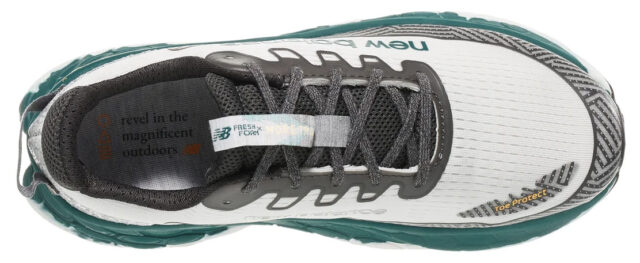
That’s not to say that the More Trail v3 caters exclusively to folks with wide feet, though it does bias in that direction, in my opinion. Runners with narrow feet will likely need to rely on the shoe’s gusseted tongue and relatively unstructured upper to manually lock in a secure fit, which is not without its pros and cons. Because the upper is so pliable, it’s easy to cinch down. However, because of that same reason, keeping a consistent fit without having to re-tie the shoe’s laces can be elusive. On a handful of longer efforts, I found myself having to stop to go through that process myself, and I’d describe my feet as average to slightly wide. Even though foot security isn’t as much of a priority in shoes of this type designed for ultra-distances when slower speeds are implied, I do think it’s worth calling out.
Most maximal trail shoes leverage rockered sole geometry to help orient the foot during the gait cycle, among other things, and the More Trail v3 is no different. Rockered soles also help take a bit of stress off of the Achilles tendon. As such, the shoe’s heel collar is left pretty plain. It’s backed by a semi-rigid heel counter and a lip of raised padding that I felt to be largely unremarkable. The More Trail v3’s heel design was not something I actively thought about while running, meaning it did its job. I’d also note that, as with the New Balance Hierro v7 GTX that I’m also currently in the process of reviewing, the More Trail v3 runs true to my US Men’s size 8.5.
Weight
Picking up the More Trail v3 for the first time confused the hell out of me. It was far lighter in hand than I expected it to be, given its imposing size, so much so that I guessed its weight to be a lot lower than what the scale ultimately read. 320 g for a US Men’s size 9 makes the More Trail v3 one of the heaviest models on the market, but that measurement is illusory on foot. The shoe never felt bogged down or bloated, credit to the airiness of Fresh Foam X foam. New Balance also spared a few grams by limiting the coverage of the More Trail v3’s rubber outsole to high-use areas under the forefoot and sections of the heel, consequently leaving a ton of midsole exposed to the ground. I’ll get to whether or not I like this decision in the “Outsole” and “Durability” portions of this review, but there’s no denying that it helps ensure the shoe retains at least a modicum of nimbleness. For more context, here’s how the shoe’s stated weight compares to the stated weights for some other similar models All weights are based on a US Men’s Size 9.
289 g / 10.2 oz — Nike Pegasus Trail 4
295 g / 10.4 oz — On Cloudultra
300 g / 10.6 oz — Inov-8 Trailfly G 300
309 g / 10.9 oz — The North Face Enduris II
312 g / 11 oz — Brooks Caldera 6
312 g / 11 oz — Saucony Endorphin Trail
317 g / 11.2 oz — Altra Mont Blanc BOA
320 g / 11.3 oz — New Balance Fresh Foam X More Trail v3
332 g / 11.7 oz — Hoka Stinson ATR 6
350 g / 12.3 oz — Altra Olympus 5
Echoing my previous points, the importance of a shoe’s weight is entirely context dependent, so while gram measurements that begin with a 3 are generally enough to furrow my brow, I think the More Trail v3 is an exception, considering most folks will likely use it for long, slow efforts. So far, energy return from the shoe’s midsole has kept it feeling pretty spry. If / when that stops being the case, I could see the More Trail v3’s weight becoming more of an issue. As always, if anything changes down the line I’ll be back with updates.
Upper
It’s tough to really penalize a shoe for being environmentally conscious. The tremendous size of the footwear industry’s carbon footprint has been well documented, and given that most runners are pretty green, I expect that efforts to mitigate it through more efficient production practices will be a trend that continues to grow. With that caveat out of the way, the More Trail v3’s choice of upper material hurts the shoe’s performance. New Balance uses an engineered mesh, save for a thin TPU toe rand — part of their “Toe Protect” technology — that follows the shoe just above the midsole all the way to the midfoot. The mesh fabric is lightweight and flexible, more typical of what I’d expect on a road shoe, not a model intended for ultra-distance efforts on trail. In the “Fit” section, I commented on how this pliability served as a double-edged sword of sorts, allowing for a precise fit that it did a poor job of hanging onto. Provided with a few more supportive overlays, I think the More Trail v3’s upper would likely have enough structure to sustain foot lockdown.
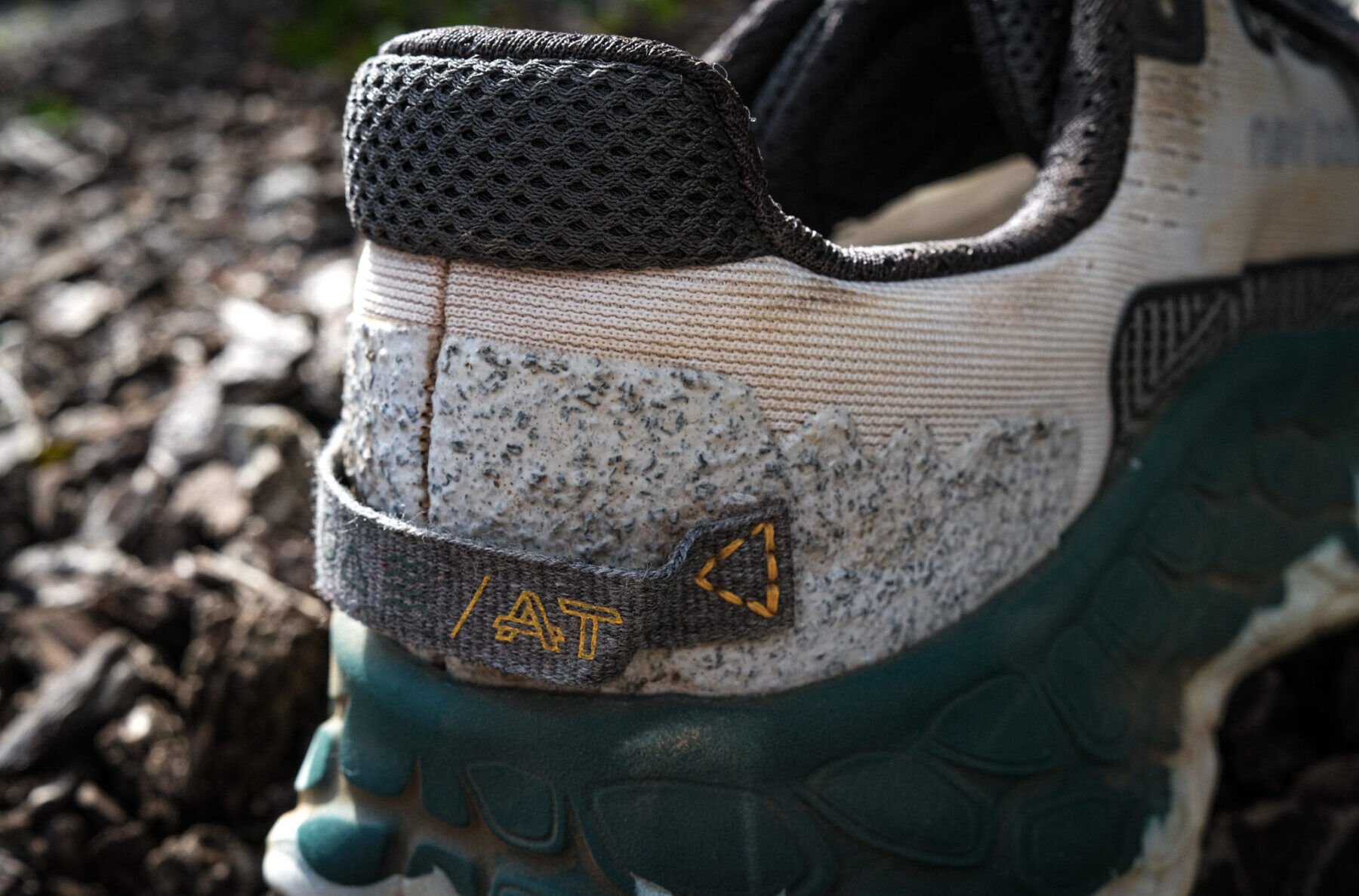
Hopefully this doesn’t come across as too snarky, but I’m at a loss with what to do with shoes that don’t fully gusset their tongues. It’s a simple way to improve fit pretty much universally; it’ll likely improve the shoe’s durability; and from a technical standpoint, seems pretty easy to execute. The More Trail v3 is spared from most of my criticism because it does have a gusseted tongue, however, I can’t quite let it off the hook.The material New Balance uses for the More Trail v3’s tongue and laces feel pretty poorly made and flimsy. Even gusseted, the tongue would still occasionally bunch up on runs, forcing me to stop and untangle the yarn-like laces that have already started to fray. Though not a complete dealbreaker, New Balance’s lack of detail / thoughtfulness in this area left me disappointed. I’m all for using as much recycled material as possible, just as long as it doesn’t negatively impact a shoe’s functionality. If that’s the case, you’re just creating even more waste.
The More Trail v3’s ankle / heel collar is consistent with the rest of the shoe’s build (i.e., both are spartan, lightly cushioned, and very noodly). I have less of an issue with this section being slightly under designed because the shoe’s rockered sole will help reduce some of its workload. It’s not confidence inspiring though, and considering how many risks New Balance took in giving the More Trail v3 such an aggressively tall stack height, I was expecting the shoe’s upper to be more robust and supportive.
Midsole
The More Trail v3 is pretty much all midsole. New Balance states the shoe’s stack height is 30.5 mm / 25.9 mm, but I’m not entirely sure where they are getting those numbers, to be frank. I’ve tested a bunch of maximal shoes within the past year, including Altra’s maximally stacked Olympus 5 (33 mm / 33 mm), and the More Trail v3 feels higher off the ground than even that. Accurately diagnosing stack height at home is near impossible, so what follows is at best just a guess, but I’d speculate that the shoe’s true measurements are probably something like 44 mm / 40 mm. The More Trail v3’s midsole sidewalls also rise up several millimeters above the footbed, creating an illusion that its stack height is even taller than it actually is.
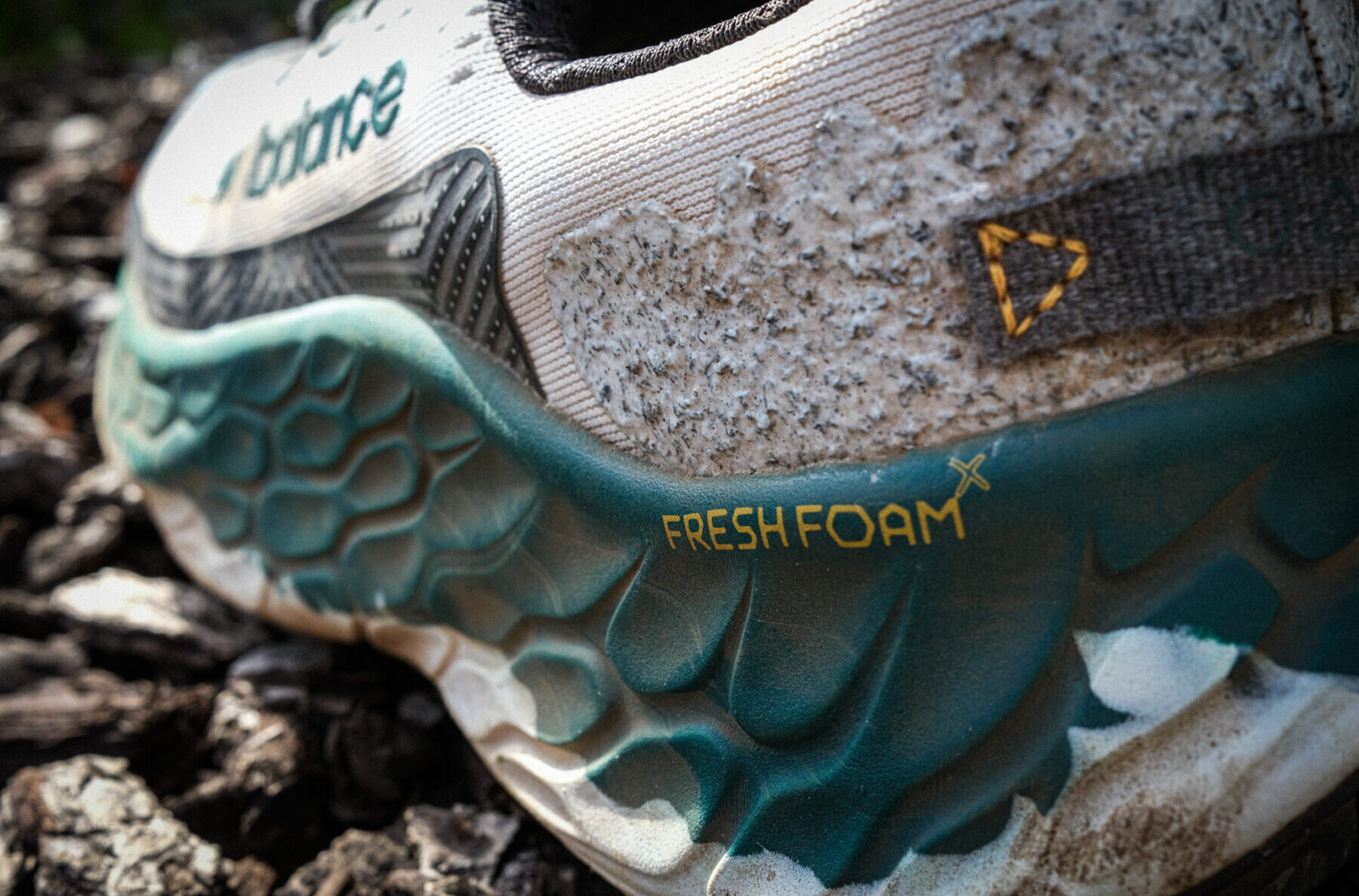
While I’m not the biggest fan of this look, I do think it makes sense from a design standpoint because doing so likely increases the shoe’s overall stability. For that same reason, New Balance elected to install a low heel-to-toe drop (4 mm) partnered with rockered sole geometry, a move typical of super maximalist shoes that, in theory, should help steadily transition the foot through its gait cycle. Hoka has relied on this setup for years, and based on their success, as well as my own experience, there’s little doubt that it works in a lot of contexts.
To draw another comparison between the More Trail v3 and Hoka, I can’t help but compare New Balance’s “Fresh Foam X” midsole material to the lightweight EVA Hoka uses in models like the Challenger 7. Both foams are positioned for comfort first and foremost, meaning that they feel softer than popular performance composites like Nike’s “ZoomX.” So far, Fresh Foam X foam has followed a similar trajectory as Hoka’s EVA. The More Trail v3 felt bouncy, forgiving, and deceptively airy for the first 50 miles, requiring little to no break-in period. As the shoe crept toward the 100-mile mark, I got the sense that the midsole’s energy return began to slack, akin to a painfully slow-leaking tire.
If we stick to that analogy and see the More Trail v3’s “packing out” sensation as comparable to riding a mountain bike with low tire pressure, we can’t ignore some of the advantages that brings. The shoe’s midsole has less “oomph,” yes, but it’s become much more flexible as a result, in turn awakening previously dormant ground feel. Again, given that the More Trail v3 is a model that leaves no ambiguity about its preference for long, slow efforts, I much prefer the added nimbleness that its broken-in midsole provides, even at the expense of some energy return. I have a lot more confidence running in the shoe on moderately technical sections of singletrack, whereas doing so before felt foolish. Maximally stacked Hokas that I’ve worn in the past eventually settle into a consistent ride after about 150 miles, so I’ll be curious to see whether or not New Balance’s Fresh Foam X shares a parallel future.
Outsole
As with the More Trail v3’s upper, New Balance uses some recycled material to build out the shoe’s outsole — and suffers some consequences because of it, in my opinion. Instead of Vibram’s arguably best-in-class “MegaGrip” compound, which would have been right at home on a model like the More Trail v3, we get the rarely seen “Vibram Eco-Step EVO,” a type of reclaimed rubber that’s not nearly as tacky. The outsole rubber is also not full-length but instead broken into zones under high-use areas like the forefoot and heel.
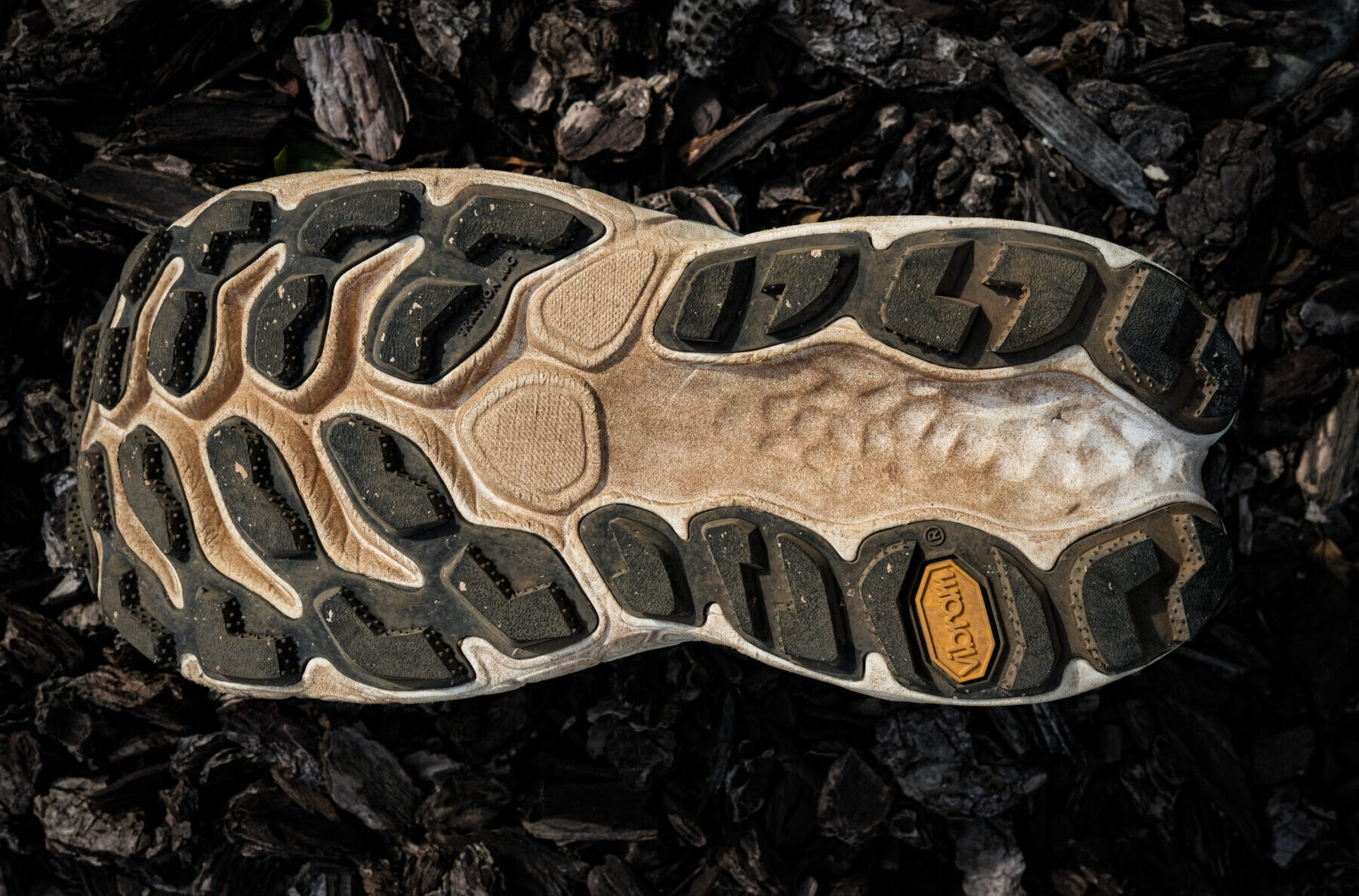
Where Vibram Eco-Step EVO is present, it assumes the shape of some pretty oversized, imprecise lugs. Their surface area and lack of stickiness undermine their 5 mm depth, which would otherwise usually imply significant grip (most trail shoes not explicitly intended for mud / snow have 3-4 mm lugs). I frequently slipped off of rocks while wearing the shoe and had to brake excessively into corners on buffed-out trails to ensure that I wouldn’t slide out. As far as silver linings go, the More Trail v3’s confusing outsole design did translate well on the roads. That’s a pretty meager consolation for a critical part of the shoe that I wish New Balance would have executed better. For my money, “Vibram MegaGrip Litebase” could have easily boosted its traction while also keeping weight down.
On Trail
I have some very very long runs planned this summer, so finding myself in a pair of the More Trail v3 felt like fortuitous timing. For past reviews, I took many of the shoes I’ve reviewed through a similar testing process that involves 6 days of running a week with one workout (usually some type of hill interval), a collection of social runs, and a lengthier effort between 3 and 5 hours. But this time around I went off script and, aside from 2-3 short break-in runs, used the More Trail v3 exclusively for long efforts (> 3 hours of time on feet). It goes without saying that this shoe is decidedly not for workouts / short races. You might be able to talk me into using it for recovery runs on beat-up legs, but I’d consider that an incidental use case for a model that really thrives the more miles you log in one go.
Given the More Trail v3’s tall stack height, I stuck to running on mostly fire roads in the Marin Headlands just north of San Francisco, mainly out of an abundance of caution for my ankles. The shoe easily rumbled over gravel, helped out in large part by its rockered sole. While ascending most of the climbs that give the Headlands their profile — all of which have been graded for horses — I did feel like I lost contact with the ground. The More Trail v3’s midsole zapped a good chunk of my power output moving uphill, but its size never prevented me from getting up on my toes and into proper running form when climbing (i.e., with weight shifted forward).
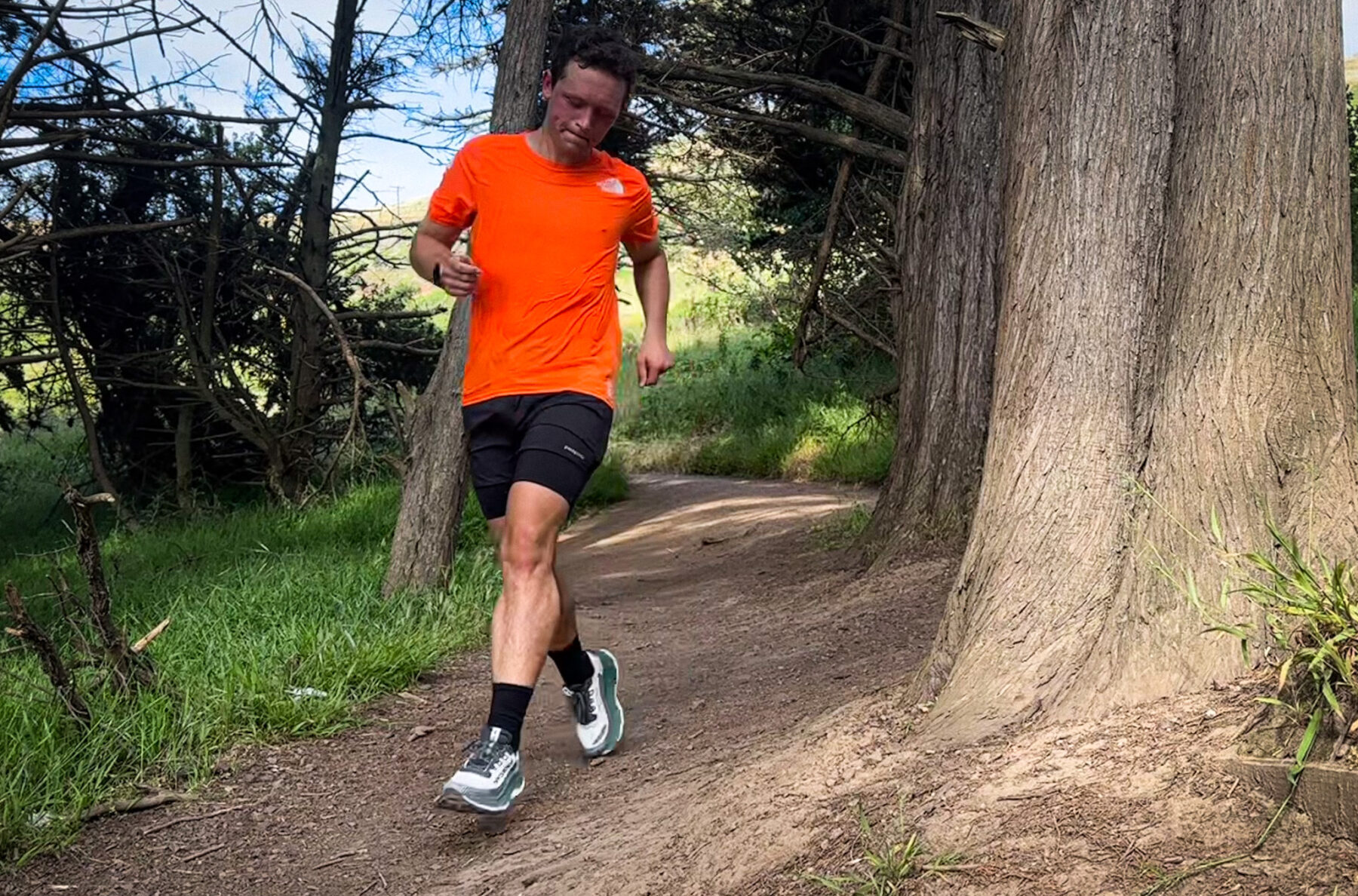
Durability
The More Trail v3 is built for long runs but probably not a very long life, it turns out. While I’m sure some folks will be able to milk a defensible amount of miles out of the shoe, I expect most to be disappointed by its lack of longevity. As I see it, the More Trail v3’s durability issues are twofold: its maximal stack height requires the use of lightweight foam that’s prone to rapid compression, and the materials that New Balance uses (particularly in the upper and outsole) compromise its build quality. I’ve yet to reach 100 miles in my pair and the midsole’s energy return has already declined, the upper shows signs of wear, and the outsole is starting to take a beating. I’m undeniably a fan of the More Trail v3, I just wish New Balance had made it more robust to handle the high mileage it’s positioned to take on. As always, if anything changes down the line I’ll be back with updates.
Who’s It For?
I’ve been around enough ultramarathons to know that the majority of people that toe the line at these types of events are mid-to-back-of-the-packers whose “A” goal is usually just to cover the distance in a timely manner. The More Trail v3 caters primarily to this population, in my opinion — the non-elites of us who will likely be reduced to a walk / hike at some point during the event. The shoe’s broad platform and high amount of cushioning support wide feet and heavier runners, and because its unwieldiness all but prevents running at high speed, it’s ideal for folks content to shuffle along in lieu of opening up their stride. As a training option, I’d recommend saving the More Trail v3 for long runs in excess of 20 miles if your training volume is on the high side; half of that if you run sparingly. As a racing option, I don’t think there’s really an upper limit for the distance the More Trail v3 is comfortable tackling. Forced to be more specific, I’d probably save the shoe for non-technical 100-mile efforts and up, though I realize that’s extremely particular.
Bottom Line
The New Balance Fresh Foam X More Trail v3 is a lot of shoe by just about any standard. As perhaps the most cushioned trail shoe currently on the market, it faces the potential pitfalls of models in the hyper-maximalist category, including instability on uneven terrain, a precipitous decline in energy return from lightweight foam, and a lack of ground feel. However, the More Trail v3 has managed to mostly skirt these issues, performing as a deceptively balanced, (relatively) wieldy, and comfortable ultra-distance option for folks looking to steamroll over trails. There are a few outstanding concerns about its durability that stem from the materials that New Balance uses in both its upper and outsole, as well as just how long its midsole will be able to hang onto sufficient energy return, but they’re all far from deal breakers and only just slightly detract from an otherwise thoughtfully conceived trail shoe.

